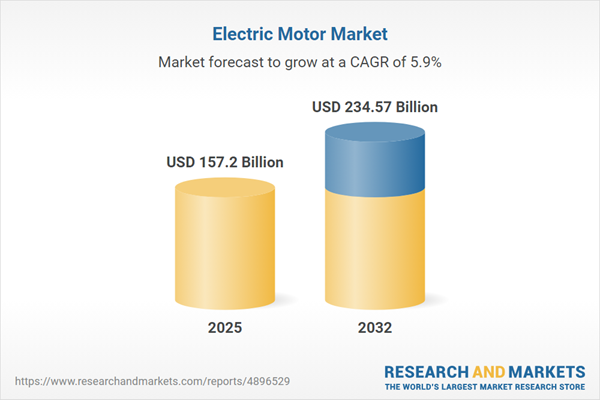Speak directly to the analyst to clarify any post sales queries you may have.
Senior executives face shifting dynamics as the electric motor market evolves with technological innovation, regulatory change, and heightened sustainability pressures. Achieving operational agility and business growth depends on aligning procurement and investments with broader industry shifts and resilient practices.
Market Snapshot: Electric Motor Market Size and Outlook
The global electric motor market achieved a value of USD 148.53 billion in 2024 and is projected to reach USD 157.20 billion by 2025, reflecting a compound annual growth rate of 5.87%. By 2032, the market is expected to attain USD 234.57 billion, supported by the ongoing integration of electrification across manufacturing, transport, and infrastructure. Senior leaders are responding to policy and ecological imperatives by investing in advanced motor technologies, which not only strengthen regulatory compliance but also foster operational resilience. Amid this changing environment, reinforcing supply chain strategies and maintaining adaptability are critical to sustaining competitive efficiency.
Scope & Segmentation: Electric Motor Market
This report provides a strategic decision-making framework for executives managing rapid transformations within the electric motor sector. A detailed segmentation approach ensures precise alignment with distinct operational and investment priorities:
- Type: AC and DC options—including induction, synchronous, brushed, and brushless motors—enable application versatility for both industrial and commercial needs.
- Power Rating: Solutions span from ultra-low to high-power, allowing tailored deployments for environments ranging from heavy industry to specialized consumer applications.
- End-User Industry: Adoption covers aerospace, automotive, marine, energy, industrial machinery, and appliances, each demanding unique specification and customization factors.
- Cooling Type: Air-cooled and water-cooled configurations—including IPM, ODP, TEFC, and TENV—address heat management challenges across various operational contexts.
- Phase: Single-phase and three-phase motors enhance flexibility for both standard and specialized use cases.
- Application: Core uses include powering compressors, pumps, fans, conveyors, and machine tools, underscoring the need for reliability in daily operations.
- Mounting Type: Face, flange, and foot mounting solutions simplify integration in new installations and retrofits.
- Frame Material: Aluminum, cast iron, and steel choices offer adaptability to different operational environments and lifecycle requirements.
- Insulation Class: Classes B, F, and H support applications with varying heat load demands, ensuring compliance with industrial safety requirements.
- Regions: Coverage includes the Americas, Europe, Middle East & Africa, and Asia-Pacific, each shaped by distinct regulatory conditions and opportunities for innovation.
- Key Companies: Market influence is shaped by Nidec, Siemens, ABB, General Electric, Bosch, Schneider Electric, WEG, Regal Rexnord, Yaskawa Electric, and Toshiba, who define technology trends and competitive actions.
Key Takeaways for Senior Decision-Makers
- Adopting advanced power electronics and control systems aligns technology investments with long-term productivity and sustainability objectives.
- Digital monitoring and predictive maintenance help minimize operational interruptions, enhancing consistency and asset reliability.
- A proactive response to evolving regulations positions organizations to implement energy-efficient solutions and embed compliance within business models.
- Global expansion introduces varying regulatory demands, making local expertise and strategic planning essential for market entry.
- Agile sourcing and technology-enabled procurement protect against uncertainties in supply chain dynamics and maintain operational continuity.
Tariff Impact: Navigating 2025 Supply Chain Disruptions
Recent U.S. tariffs on essential electric motor components—including magnets and bearings—are prompting manufacturers to reevaluate procurement networks and compliance practices. To reduce risk from international supply fluctuations, building local supplier relationships, investing in regional procurement, and optimizing design strategies can bolster consistency and performance despite shifting trade requirements.
Methodology & Data Sources
This report integrates direct executive interviews, thorough financial analysis, and industry benchmarking, ensuring results are anchored in validated data. The diverse perspectives and established references provide executives with a reliable foundation for high-stakes market decisions.
Why This Electric Motor Market Report Matters
- Equips leadership teams to drive electrification and automation strategies, increasing adaptability and supporting sustainable operational practices.
- Clarifies technology innovation impacts and regulatory developments, giving organizations tools to balance risk and pursue new market opportunities.
- Delivers actionable guidance for supply chain evolution, supporting robust procurement responses to new compliance and market challenges.
Conclusion
With actionable intelligence and comprehensive sector analysis, senior decision-makers are positioned to sustain organizational resilience and uphold competitive standing as the electric motor market continues to advance.
Additional Product Information:
- Purchase of this report includes 1 year online access with quarterly updates.
- This report can be updated on request. Please contact our Customer Experience team using the Ask a Question widget on our website.
Table of Contents
3. Executive Summary
4. Market Overview
7. Cumulative Impact of Artificial Intelligence 2025
Companies Mentioned
The companies profiled in this Electric Motor market report include:- Nidec Corporation
- Siemens Aktiengesellschaft
- ABB Ltd
- General Electric Company
- Robert Bosch GmbH
- Schneider Electric SE
- WEG S.A.
- Regal Rexnord Corporation
- Yaskawa Electric Corporation
- Toshiba Corporation
Table Information
| Report Attribute | Details |
|---|---|
| No. of Pages | 196 |
| Published | October 2025 |
| Forecast Period | 2025 - 2032 |
| Estimated Market Value ( USD | $ 157.2 Billion |
| Forecasted Market Value ( USD | $ 234.57 Billion |
| Compound Annual Growth Rate | 5.8% |
| Regions Covered | Global |
| No. of Companies Mentioned | 11 |









